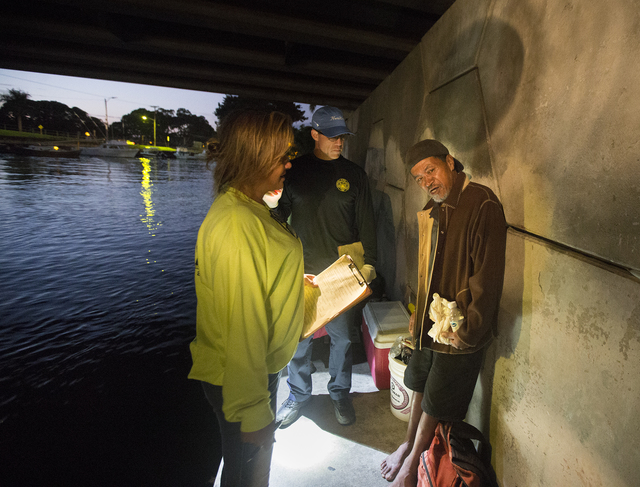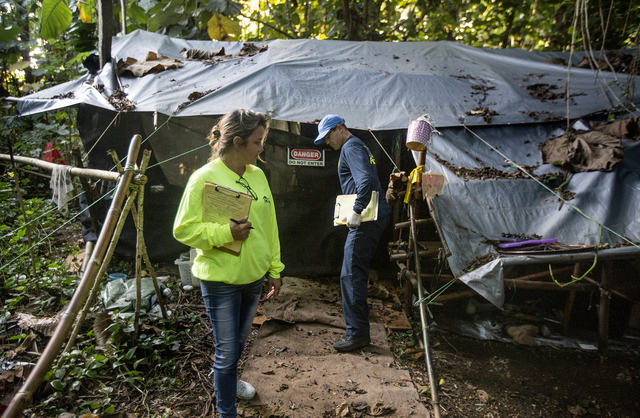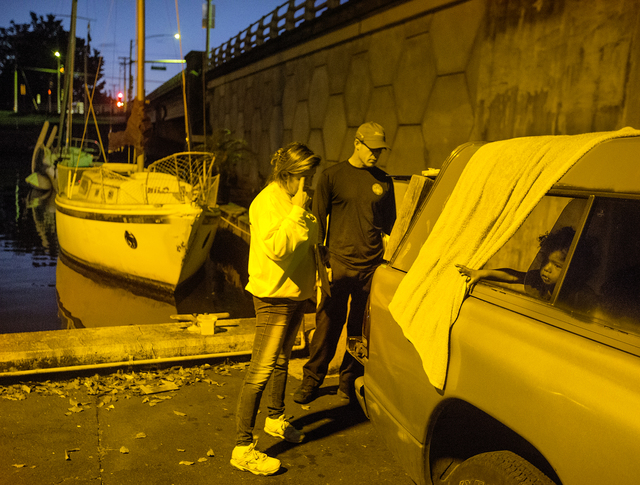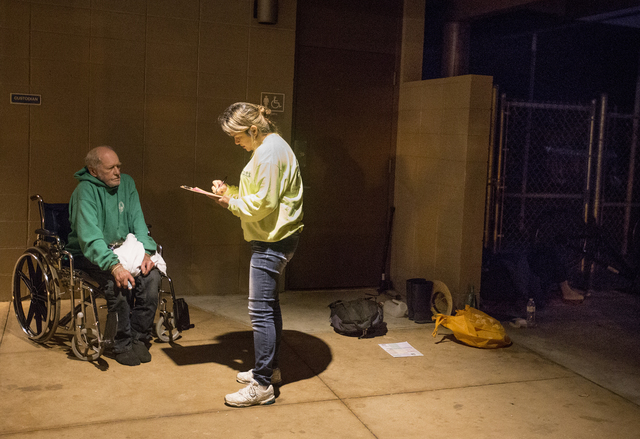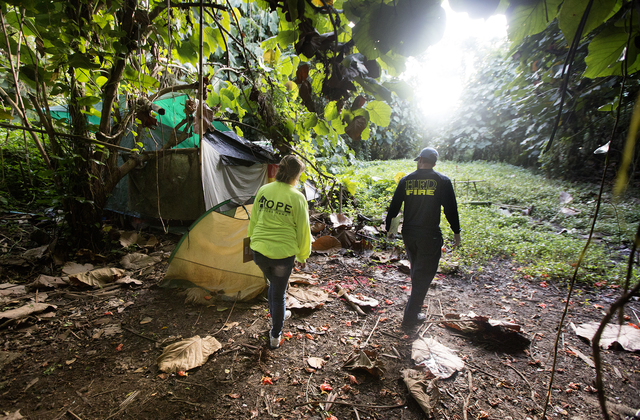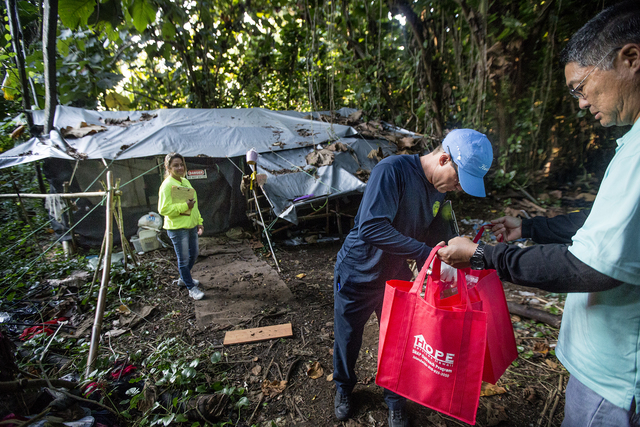Effort to count homeless searches for those in need
Warm sunshine poured over Nadine Ageres’ tent encampment Monday morning, but the 52-year-old remained bundled up in a blanket. The night before, she’d slept outside — and temperatures had dipped into chilly overnight lows.
ADVERTISING
“Last night was super cold,” Ageres said to a similarly blanket-clad woman sharing the encampment. “Really, really cold.”
On this nondescript weekday morning, as park-goers cruised through Wailoa River State Park about 100 yards away, Ageres, along with other occupants in the cluster of tent encampments nearby, were just rising.
For many, this is home.
It isn’t completely ideal — the mosquitoes can be relentless, and many days, after a few nights sleeping on the earth floor, one wakes up with a stiff back. But the occupants are mostly friends, and there are some makeshift creature comforts scattered around, such as a jutting tree branch nearby for drying clothing.
And in Hawaii, where minimum wage is $8.50 per hour, and one would need about $22 per hour to afford a two-bedroom home, many of the state’s growing number of homeless people have few other options.
“People end up piling into housing and either someone gets kicked out, or there ends up being conflict with a lot of people living there,” said Malu Debus, volunteer and community partnership coordinator for HOPE Services Hawaii. “So the only way someone could afford to live in Hawaii without some sort of help or subsidy is if they worked 114 hours per week — and that’s not going to happen, no one is going to be a machine.”
HOPE Services, which is the largest provider of homeless services on the island, thinks the problem is getting worse. Last week, the nonprofit group led the Homeless Point in Time Count — a yearly, weeklong effort which aims to gauge the island’s current number of sheltered and unsheltered homeless individuals.
The more than 50 HOPE employees and volunteers from entities including the Hawaii County Civil Defense Agency, Hawaii Fire Department and Emergency Medical Services, Hawaii County Office of Housing and Community Development, started each day well before the crack of dawn to survey as many of the island’s homeless as possible.
Volunteers divvied out food and donated supplies as they collected an assortment of survey data: “Where did you sleep last night?” they asked. “How long have you been out of housing?”
“This gives us an accurate count of how many people need our help,” Debus said. “We rely on this number in order to provide accurate information to those who give us grants so that we can continue the programs we have. If we didn’t do this count every year, we wouldn’t know what to say to those who are giving us grants, and we’d probably become underfunded and not be able to provide the support that we do to the community.”
Data from this year’s count won’t be available until later in the spring. But past count information indicates the Big Island’s homeless population has increased each year. In 2015, 1,241 homeless individuals were counted, up from 869 in 2014. In 2013, that number was 557.
Officials at HOPE Services also think last year’s number was on the low side. This year, they estimate counting several hundred more.
“Because we have so many people helping us this year, we are thinking we’ll get a much more accurate count,” Debus said. “We really think it’s closer to 2,000.”
Just after 5 a.m. Monday, HOPE’s Homeless Outreach Specialist Leilani Ulu, along with her team of volunteers, parked near the Edith Kanakaole Multipurpose Stadium. Outside, an elderly man was slumped on the concrete, a wheelchair nearby.
“Good morning,” Ulu said in a bright voice. “I’m sorry to bother you. Can you help us with a survey?”
The volunteers leave him and nearby individuals with food and supplies.
Throughout the morning, they survey several spots around town before the sun rises. Many folks are sleeping in cars. Others are camped out underneath Wailoa River bridge. Another is curled up in his fishing boat.
Eighteen-year-old Aaron Alvarez is in Wailoa River State Park, packing up after a night in the park’s covered picnic enclosure.
“We’re like family,” Alvarez said, indicating to the smattering of individuals around him. “Everyone here looks out for each other. If I have something they need, I’ll lend it to them or give it. We all try to help each other out.”
Addressing the growing homeless problem can be difficult — and enforcing even more so. The Department of Land and Natural Resources told the Tribune-Herald in an email that “State Parks is considering different options to secure the (Wailoa River State Park) area.”
“DLNR and other agencies are working in coordination with the governor’s coordinator on homeless to address this issue in different locations,” spokeswoman Deborah Ward said in an email.
This year, state lawmakers have proposed several bills to help address the state’s homeless problem long-term. One would appropriate funds for the shallow rent subsidy program, for homeless working folks who are ready to rent permanent housing. Another would implement a lottery and use proceeds to address homelessness.
Ultimately, Debus said, the problem boils down to a high cost of living, low wages and lack of low-income housing.
“The cost of living is insane, and we don’t have a lot of answers right now,” Debus said. “That’s something that needs to be figured out at the Legislature. But we do what we can until there’s a permanent answer that can be provided to the community.”


